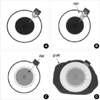1. Allen RC, Bellows AR, Hutchinson BT, Murphy SD. Filtration surgery in the treatment of neovascular glaucoma. Ophthalmology. 1982. 89:1181–1187.

2. Law SK, Nguyen A, Coleman AL, Caprioli J. Comparison of safety and efficacy between silicon and polypropylene Ahmed glaucoma valves in refractory glaucoma. Ophthalmology. 2005. 112:1514–1520.
3. Kim JC, Tseng SC. The effects on inhibition of corneal neovascularization after human amniotic membrane transplantation in severely damaged rabbit cornea. Korean J Ophthalmol. 1995. 9:32–46.
4. Molteno AC. New implant for drainage in glaucoma. Clinical trial. Br J Ophthalmol. 1969. 53:606–615.

5. Lloyd MA, Baerveldt G, Heuer DK, Minckler DS, Martone JF. Initial clinical experience with the Baerveldt implant in complicated glaucoma. Ophthalmology. 1994. 101:640–650.
6. Krupin T, Podos SM, Becker B, Newkirk JB. Valve implants in filtering surgery. Am J Ophthalmol. 1976. 81:232–235.

7. Coleman AL, Hill R, Wilson MR, Choplin N, Kotas-Neumann R, Tam M, Bacharach J, Panek WC. Initial clinical experience with the Ahmed Glaucoma Valve implant. Am J Ophthalmol. 1995. 120:23–31.

8. Ayyala RS, Zurakowski D, Smith JA, Monshizadeh R, Netland PA, Richard DW, Layden WE. A clinical study of the Ahmed glaucoma valve implant in advanced glaucoma. Ophthalmology. 1998. 105:1968–1976.
9. Brandt JD. Patch grafts of dehydrated cadaveric dura mater for tube-shunt glaucoma surgery. Arch Ophthalmol. 1993. 111:1436–1439.

10. Egrilmez S, Yagci A, Ates H, Azarsiz SS, Andac K. Glaucoma implant surgery with autogenous fascia lata in scleromalacia perforans. Ophthalmic Surg Lasers Imaging. 2004. 35:338–342.

11. Smith MF, Doyle JW, Ticrney JW. A comparison of glaucoma drainage implant tube coverage. J Glaucoma. 2000. 11:143–147.

12. Jacob T, LaCour OJ, Burgoyne CF, LaFleur PK, Duzman E. Expanded polytetrafluoroethylene reinforcement material in glaucoma drain surgery. J Glaucoma. 2001. 10:115–120.

13. Szentmary N, Szende B, Suveges I. Epithelial cell, keratocyte, and endothelial cell apoptosis in Fuchs' dystrophy and in pseudophakic bullous keratopathy. Eur J Ophthalmol. 2005. 15:17–22.
14. Funderburgh JL, Hevelone ND, Roth MR, Funderburgh ML, Rodrigues MR, Nirankari VS, Conrad GW. Decorin and biglycan of normal and pathologic human corneas. Invest Ophthalmol Vis Sci. 1998. 39:1957–1964.
15. Lin PY, Wu CC, Lee SM. Combined phototherapeutic keratectomy and therapeutic contact lens for recurrent erosions in bullous keratopathy. Br J Ophthalmol. 2001. 85:908–911.

16. Tsai TC, Su CY, Lin CP. Anterior stromal puncture for bullous keratopathy. Ophthalmic Surg Lasers Imaging. 2003. 34:371–374.

17. Koenig SB. Annular keratotomy for the treatment of painful bullous keratopathy. Am J Ophthalmol. 1996. 121:93–94.

18. Alino AM, Perry HD, Kanellopoulos AJ, Donnenfeld ED, Rahn EK. Conjunctival flaps. Ophthalmology. 1998. 105:1120–1123.

19. Pires RT, Tseng SC, Prabhasawat P, Puangsricharern V, Puangsricharern V, Maskin SL, Kim JC, Tan DT. Amniotic membrane transplantation for symptomatic bullous keratopathy. Arch Ophthalmol. 1999. 117:1291–1297.

20. Kim JC, Tseng SC. Transplantation of preserved human amniotic membrane for surface reconstruction in severely damaged rabbit corneas. Cornea. 1995. 14:473–484.

21. Kim DJ, Yoon KC, Park YG. Amniotic membrane transplantation and use of adjunctive mitomycin C in the treatment of symblepharon. J Korean Ophthalmol Soc. 2005. 46:1108–1113.
22. Cho DY, Chung BS, Choi KC. The effect of amniotic membrane patch in wound healing of skin defect. Korean J Dermatol. 2005. 43:926–932.
23. Kwon YS, Song YS, Kim JC. New treatment for band keratopathy: superficial lamellar keratectomy, EDTA chelation and amniotic membrane transplantation. J Korean Med Sci. 2004. 19:611–615.

24. Shimazaki J, Shinozaki N, Tsubota K. Transplantation of amniotic membrane and limbal autograft for patients with recurrent pterygium associated with symblepharon. Br J Ophthalmol. 1998. 82:235–240.

25. Tseng SC, Li DQ, Ma X. Suppression of transforming growth factor-beta isoforms, TGF-β receptor type II, and myofibroblast differentiation in cultured human corneal and limbal fibroblasts by amniotic membrane matrix. J Cell Physiol. 1999. 175:325–335.

26. Kim JS, Kim JC, Na BK, Jeong JM, Song CY. Amniotic membrane patching promotes healing and inhibits proteinase activity on wound healing following acute corneal alkali burn. Exp Eye Res. 2000. 70:329–337.








 PDF
PDF ePub
ePub Citation
Citation Print
Print


 XML Download
XML Download